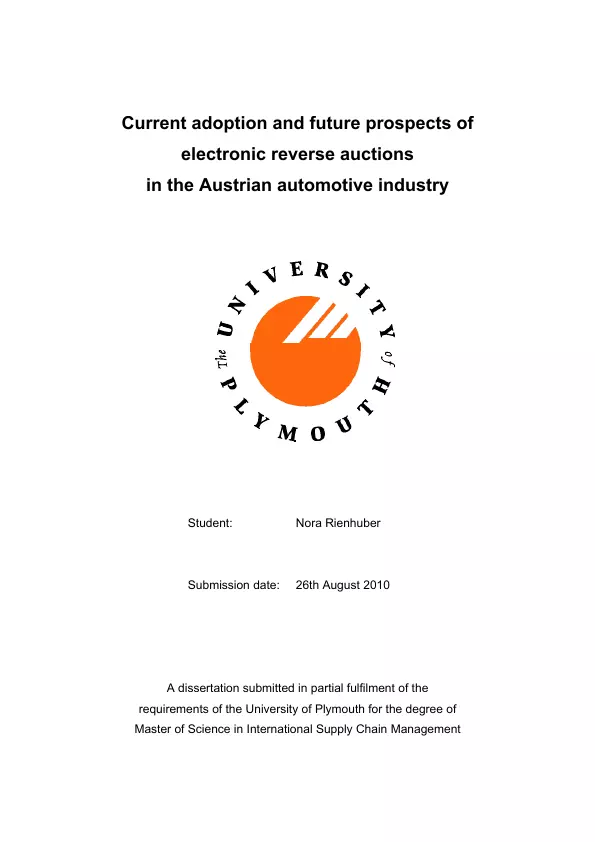Especially after the recession, it is of interest whether electronic reverse auctions (eRAs), as e-procurement tool with a high cost saving potential, are attractive for companies. Therefore, the purpose of this study is the investigation of the current eRA adoption and future eRA prospects in terms of extent and way of usage in the Austrian automotive industry. Data were collected from purchasing managers and purchasing agents of 20 companies which belong to the 24 top-selling Austrian automotive companies. Quantitative data was collected from 20 companies regarding the extent of eRA usage. Furthermore, 18 of these participated in semi-structured interviews for qualitative data collection regarding reasons for (not) using eRAs and the way of eRA usage. Results of the data analysis show that the extent of eRA usage is and will remain quite low in the Austrian automotive industry and even adopters’ eRA spending is fairly low. In conclusion, eRAs do not seem to contribute a lot to achieve cost savings in the Austrian automotive industry and are considered to be rather disliked by Aus-trian automotive buyers. Although findings cannot be generalised to the whole Austrian automotive industry they still might have the implication that buyer-supplier cooperation will prevail in the Austrian automotive industry in the future as it obviously contributes more to gain a sustainable competitive supply chain advantage than eRAs. Moreover, if other industries and countries have similar attitudes towards eRAs as Austrian automotive buyers, it might have negative implications on eRA tool providers, though this needs to be investigated in further research.
Inhaltsverzeichnis (Table of Contents)
- INTRODUCTION
- BACKGROUND, SUBJECT AND REASONS FOR SUBJECT CHOICE
- RESEARCH OBJECTIVES AND QUESTIONS
- RESEARCH METHODOLOGY
- LIMITATIONS OF THE RESEARCH
- RESEARCH STRUCTURE
- LITERATURE REVIEW
- PROCUREMENT IN SUPPLY CHAIN MANAGEMENT
- e-procurement
- e-auctions
- ELECTRONIC REVERSE AUCTIONS
- Mode of operation
- Benefits and criticisms
- Future prospects
- Adopters
- THE AUTOMOTIVE INDUSTRY
- eRA adoption in the automotive industry
- The Austrian automotive industry
- CONCEPTUAL FRAMEWORK
- METHODOLOGY
- RESEARCH PURPOSE
- RESEARCH APPROACH
- RESEARCH STRATEGY
- Sampling
- DATA COLLECTION METHOD
- Primary data collection through a telephone survey and semi-structured interviews
- DATA ANALYSIS
- Computer Assisted Qualitative Data Analysis
- Data analysis with NVivo
- CURRENT EXTENT OF ERA USAGE
- FINDINGS, ANALYSIS AND DISCUSSION
- Non-adoption reasons and criticisms
- Adoption reasons and benefits
- CURRENT WAY OF ERA USAGE
- General way of usage
- Before the auction
- Auction
- After the auction
- FUTURE PROSPECTS FOR THE EXTENT OF ERA USAGE
- FUTURE PROSPECTS FOR THE WAY OF ERA USAGE
- CONCLUSION
- CONCLUSION OF RESEARCH
- RELIABILITY AND VALIDITY
- CONSTRAINTS, LIMITATIONS AND IMPLICATIONS
- FURTHER RESEARCH
Zielsetzung und Themenschwerpunkte (Objectives and Key Themes)
This study aims to investigate the current adoption and future prospects of electronic reverse auctions (eRAs) in the Austrian automotive industry. The study seeks to determine the extent of eRA usage, the reasons for and against adopting eRAs, and the ways in which companies are utilizing eRAs. By examining these aspects, the study aims to shed light on the role of eRAs in the Austrian automotive industry's supply chain management and to provide insights into the future trajectory of eRA adoption.
- The current adoption and future prospects of electronic reverse auctions (eRAs) in the Austrian automotive industry.
- The extent of eRA usage in the Austrian automotive industry.
- The reasons for and against adopting eRAs in the Austrian automotive industry.
- The ways in which companies are utilizing eRAs in the Austrian automotive industry.
- The role of eRAs in the Austrian automotive industry's supply chain management.
Zusammenfassung der Kapitel (Chapter Summaries)
The introduction sets the stage for the study, outlining the background, subject, research objectives, methodology, limitations, and structure. Chapter 2 presents a comprehensive literature review covering key aspects of procurement in supply chain management, including e-procurement, e-auctions, and electronic reverse auctions. The chapter analyzes the benefits and criticisms associated with eRAs and explores their future prospects and adoption trends. Additionally, it delves into the specific context of the automotive industry, examining eRA adoption within this sector and focusing on the Austrian automotive industry.
Chapter 3 outlines the conceptual framework employed in the study. Chapter 4 details the research methodology, including the purpose, approach, strategy, data collection methods, and data analysis techniques. Chapter 5 presents the findings, analysis, and discussion of the study's results, focusing on the current extent of eRA usage, reasons for non-adoption and adoption, the current way of eRA usage, and future prospects for both the extent and way of eRA usage. The conclusion summarizes the key findings, assesses the reliability and validity of the research, discusses constraints, limitations, and implications, and outlines potential areas for further research.
Schlüsselwörter (Keywords)
The study explores the adoption of electronic reverse auctions (eRAs) in the Austrian automotive industry, investigating the extent of eRA usage, the reasons for and against adopting eRAs, and the ways in which companies are utilizing eRAs. Key concepts covered include e-procurement, supply chain management, cost savings, buyer-supplier relationships, and competitive advantage.
- Quote paper
- Nora Rienhuber (Author), 2010, Current adoption and future prospects of electronic reverse auctions in the Austrian automotive industry, Munich, GRIN Verlag, https://www.grin.com/document/163954



